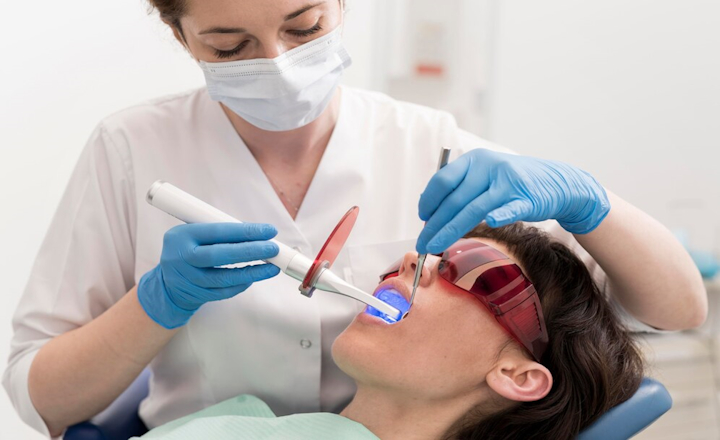
Ever wondered how dentists transform dull teeth into sparkling ones in just a single visit? Whether you've pondered this question or not, the reasons behind this remarkable teeth-whitening process are listed in this post.
Teeth whitening has become a popular cosmetic procedure, with many seeking brighter, more radiant smiles. Understanding the science behind this process can help you make informed decisions about the best methods and what to expect.
This blog delves into the mechanisms of teeth whitening, the types of procedures available, and the expected outcomes.
The Basics of Teeth Whitening
Teeth whitening is a cosmetic dental procedure that aims to lighten the color of your teeth. It primarily works by removing stains and discoloration caused by various factors such as food, beverages, tobacco, and aging. The main agents used in teeth whitening are peroxide-based compounds, which include hydrogen peroxide and carbamide peroxide. For this treatment, you must go with an expert cosmetic dentist in Adelaide who treats you with proper care.
How Whitening Agents Work
The active ingredients in whitening agents, hydrogen peroxide and carbamide peroxide, break down into oxygen molecules upon application. These oxygen molecules penetrate the enamel and dentin layers of the teeth, breaking down the bonds of stain molecules. This process results in a lighter tooth color.
Hydrogen peroxide acts more quickly because it is a smaller molecule, making it effective for shorter, more intense treatments. Carbamide peroxide, on the other hand, breaks down into hydrogen peroxide and urea, providing a slower, more sustained release of whitening power, which is why it's commonly used in at-home whitening products.
Types of Teeth Whitening
Teeth whitening can be broadly categorized into two types: professional (in-office) whitening and at-home whitening.
In-Office Whitening
A dentist performs professional whitening and typically uses higher concentrations of hydrogen peroxide. The procedure usually begins with the application of a protective barrier to the gums, followed by the application of the whitening gel to the teeth. In some cases, a special light or laser may be used to enhance the effectiveness of the gel. The entire process takes about an hour, and significant results can be seen immediately.
The advantage of in-office whitening is its effectiveness and speed. However, it can be more expensive compared to at-home options.
At-Home Whitening
At-home whitening includes over-the-counter products such as whitening strips, gels, toothpaste, and custom-fitted trays provided by a dentist. These products generally contain lower hydrogen peroxide or carbamide peroxide concentrations, making them safer for prolonged use.
Whitening strips are thin, flexible plastic strips coated with a peroxide-based whitening gel. They are applied directly to the teeth and left on for a specified period, usually 30 minutes to an hour.
Custom-fitted trays are designed by a dentist to fit your teeth perfectly. The trays are filled with a whitening gel and worn for a few hours daily or overnight, depending on the product's instructions. This method can take a few weeks to show significant results but is effective and allows for a more controlled whitening process.
What to Expect
Immediate Results
In-office whitening treatments can provide immediate and noticeable results. Teeth can become several shades lighter in just one session. However, it's important to note that the final color may take a few days to stabilize.
Gradual Improvement
At-home whitening products offer gradual improvement, with full results typically visible after a few weeks of consistent use. This method allows you to control the level of whitening and manage any potential sensitivity.
Sensitivity
One common side effect of teeth whitening is increased tooth sensitivity. This occurs because the peroxide in the whitening gel can temporarily make the enamel more permeable, exposing the nerves within the teeth to temperature changes. This sensitivity is usually temporary and subsides after the treatment is completed. Using toothpaste designed for sensitive teeth can help manage this side effect.
Longevity of Results
The longevity of whitening results varies depending on your lifestyle and oral hygiene habits. Smoking, drinking coffee, tea, and red wine, and eating highly pigmented foods can cause your teeth to stain more quickly. Maintaining good oral hygiene and using touch-up treatments can help prolong the effects of teeth whitening.
Conclusion
Teeth whitening is a scientifically backed cosmetic procedure that significantly improves tooth color by breaking down stains with peroxide-based agents. Whether you choose professional in-office treatments or at-home products, understanding how teeth whitening works and what to expect can help you achieve and maintain a brighter, more confident smile.
Always consult with your dentist before starting any whitening regimen to ensure it is safe and appropriate for your dental health. Need help booking an appointment for dental care? Visit Malvern Dental and Smile Design's website or call (08) 8166 2646. Their expert team is located at Suite 1/283-285 Unley Rd, Malvern SA 5061.





